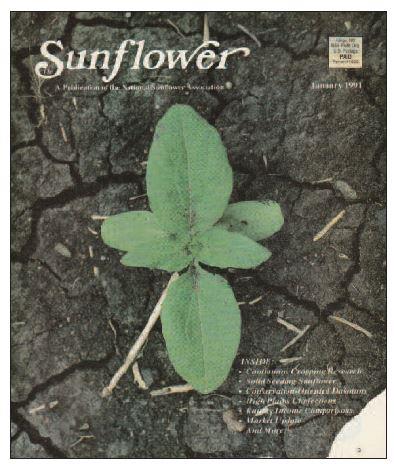Article Archives
30 Years Ago - A Look Back
Friday, January 1, 2021
filed under: Historical

Are Solid-Seeded ’Flowers for You? / By Don Lilleboe — “Some grain farmers casting an eye toward sunflower this yet have not produced the crop in the past; others grew it during the early or mid-’80s but dropped from their rotations later in the decade due to program dictates or other reasons.
“For certain grain producers in the western Dakotas and the High Plains, one key question may be this: Do I have to invest in row-crop equipment to plant and cultivate my sunflower crop?
“Veteran sunflower growers who have successfully raised several crops under a narrow-row (solid-seeded) system answer with a confident ‘no.’
“When he began raising ’flowers in the early ’80s, Donn Yatskis deliberately chose to utilize as much of his existing equipment as possible to hold down costs. That meant planting sunflower with his Kirschman grain drill rather than investing in a row-crop unit. With exception of 1990 (when he moved from oils into confections and used a JD MaxEmerge to seed them), the Buchanan, N.D., grower has had good success planting in 18-inch rows with the drill.
“Crucial to this success, Yatskis emphasizes, is proper calibration of the drill prior to heading out into the field. When calibrating, it’s important to use the same variety and seed size that actually will be planted, he stresses. ‘Different varieties and different sizes plant at different rates,’ Yatskis points out. ‘That’s less likely to happen with a MaxEmerge or air planter, since they’re set up to seed sunflower, beans, corn or whatever it is they’re planting.
“ ‘But since grain drills just meter out the seed, different sizes and varieties with different lot numbers that have more seeds per pound plant differently. . . .’
Yatskis warns that while many grain drills work well on sunflower, some models do not — mainly because of their metal-wheel metering device. ‘It has a tendency to crush the sunflower seed coat, indent the nutmeat and kill the germ,’ he reports.”
In Search of a System / By Don Lilleboe — “Fallow is a six-letter word; but to Al Black, it has four-letter connotations . . . four letters as in ‘lost’ moisture, ‘lost’ soil and ‘lost’ income for farmers.
“Black, who is director of the USDA-ARS Northern Great Plains Research Laboratory at Mandan, N.D., would like to help replace ‘lost’ with ‘conserved.’ And as leader of an extensive research project developing new information on efficient and cost-effective conservation tillage practices, he is in an excellent position to do so.
“The multi-faceted USDA project, which completed its sixth year in 1990, is unique in both the parameters of the study and its size. The experiments cover 65 acres, allowing for field-size conditions and methods. Among the several areas of study are fallow versus continuous cropping systems; three types of tillage systems (conventional, minimum-till and no-till); differing applied nitrogen rates; and various seed varieties. Also being looked at are how the different cropping systems affect — or are affected by — certain diseases and insects, and how they impact soil organic matter. . . .
“The Mandan project compares a traditional two-year spring wheat/fallow rotation with a three-year continuous-cropping system whose sequence is spring wheat/winter wheat/sunflower. After six years of research, there’s no doubt in Black’s mind that continuous cropping not only works on the dry Great Plains, but that it’s economically superior to a fallow system.”
‘What’s the Price of Erosion?’ / By Don Lilleboe — “In the spring of 1969, the usually benign Mouse River overflowed its banks and spread across much of the Mouse River Valley of north central North Dakota, turning into one of the worst floods in the annals of area history.
“Among the hundreds of farms under water that spring was that of Lawrence Scheresky. ‘Our land is fairly flat, with a three- to four-percent slope. But in the spring of both that year and the following year, we had to plow in the gullies before we could cross them,’ recalls the Des Lacs farmer more than two decades later. ‘I said to the family, “There has to be a better way of farming than summer fallowing and watching it wash away.” ’
“Scheresky’s concern about both water and wind erosion led him to become one of the first farmers in his area of Ward County to deliberately move away from the traditional wheat/summer fallow system and toward continuous cropping. Today, in an area where fallowing is still quite common, virtually all the Scheresky farm is continuously cropped; in 1990, the little that did remain in fallow was worked only once, in September.
“The chisel plow has been Scheresky’s implement of choice to date. He and son Barry have moved to two-inch points every 12 inches ‘just for the purpose of opening up the soil to take in moisture,’ he says. . . .
“The results of leaving the wheat stubble standing to catch snow and conserve moisture for the upcoming sunflower crop was dramatized to Scheresky several years ago:
“ ‘We took off a crop of wheat and left the stubble. In the fall, we made one pass around the outside of the field with a 24-foot chisel plow with 14-inch sweeps, and then made another pass diagonally,’ he recalls. ‘The next spring, we Vibra-shanked the entire field and planted sunflower. All season long, you could see where the stubble had been worked down and didn’t trap the snow well. The sunflower was six to eight inches shorter in those areas.’ ”